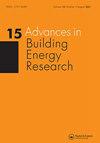Data mining of building performance simulations comprising occupant behaviour modelling
IF 2.5
Q2 CONSTRUCTION & BUILDING TECHNOLOGY
引用次数: 14
Abstract
ABSTRACT Occupant behaviour is now widely recognized as a major factor in the disparity between predicted and measured building performance. Stochastic models are a convenient way to model the rational, diverse and complex nature of occupant behaviour, including presence and adaptive behaviour. The FMI standard was used to co-simulate the building energy modelling program EnergyPlus and a multi-agent platform that contains stochastic models in an integrated environment. Using an office building as a case study, we show that data mining, through a correlation matrix and a principal component analysis, was an efficient way of investigating the cumulated influence of occupant behaviour on energy performance. The organisation of simulations was achieved using design of experiments in order to take into consideration multiple building configurations. This paper demonstrates how data mining of stochastic simulations can be used to identify the determinants that have the greatest influence on building energy needs.包括居住者行为建模的建筑性能模拟数据挖掘
摘要:现在,人们普遍认为,居住者行为是预测和测量建筑性能之间差异的主要因素。随机模型是一种方便的方式,可以对居住者行为的理性、多样性和复杂性进行建模,包括存在性和适应性行为。FMI标准用于共同模拟建筑能源建模程序EnergyPlus和集成环境中包含随机模型的多智能体平台。以一栋办公楼为例,我们表明,通过相关矩阵和主成分分析,数据挖掘是研究居住者行为对能源性能累积影响的有效方法。模拟的组织是通过实验设计实现的,以考虑多种建筑配置。本文演示了如何使用随机模拟的数据挖掘来确定对建筑能源需求影响最大的决定因素。
本文章由计算机程序翻译,如有差异,请以英文原文为准。
求助全文
约1分钟内获得全文
求助全文
来源期刊

Advances in Building Energy Research
CONSTRUCTION & BUILDING TECHNOLOGY-
CiteScore
4.80
自引率
5.00%
发文量
11
 求助内容:
求助内容: 应助结果提醒方式:
应助结果提醒方式:


